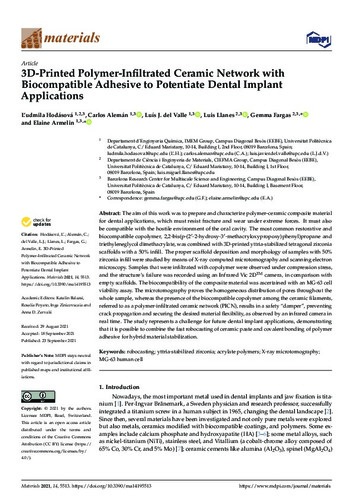Mostra el registre d'ítem simple
3D-printed polymer-infiltrated ceramic network with biocompatible adhesive to potentiate dental implant applications
| dc.contributor.author | Hodásová, L'udmila |
| dc.contributor.author | Alemán Llansó, Carlos |
| dc.contributor.author | Valle Mendoza, Luis Javier del |
| dc.contributor.author | Llanes Pitarch, Luis Miguel |
| dc.contributor.author | Fargas Ribas, Gemma |
| dc.contributor.author | Armelín Diggroc, Elaine Aparecida |
| dc.contributor.other | Universitat Politècnica de Catalunya. Doctorat en Polímers i Biopolímers |
| dc.contributor.other | Universitat Politècnica de Catalunya. Departament d'Enginyeria Química |
| dc.contributor.other | Universitat Politècnica de Catalunya. Departament de Ciència i Enginyeria de Materials |
| dc.date.accessioned | 2022-01-26T09:35:50Z |
| dc.date.available | 2022-01-26T09:35:50Z |
| dc.date.issued | 2021-09-23 |
| dc.identifier.citation | Hodasova, L. [et al.]. 3D-printed polymer-infiltrated ceramic network with biocompatible adhesive to potentiate dental implant applications. "Materials", 23 Setembre 2021, vol. 14, núm. 19, p. 5513:1-5513:14. |
| dc.identifier.issn | 1996-1944 |
| dc.identifier.uri | http://hdl.handle.net/2117/360720 |
| dc.description.abstract | The aim of this work was to prepare and characterize polymer–ceramic composite material for dental applications, which must resist fracture and wear under extreme forces. It must also be compatible with the hostile environment of the oral cavity. The most common restorative and biocompatible copolymer, 2,2-bis(p-(2'-2-hydroxy-3'-methacryloxypropoxy)phenyl)propane and triethyleneglycol dimethacrylate, was combined with 3D-printed yttria-stabilized tetragonal zirconia scaffolds with a 50% infill. The proper scaffold deposition and morphology of samples with 50% zirconia infill were studied by means of X-ray computed microtomography and scanning electron microscopy. Samples that were infiltrated with copolymer were observed under compression stress, and the structure’s failure was recorded using an Infrared Vic 2DTM camera, in comparison with empty scaffolds. The biocompatibility of the composite material was ascertained with an MG-63 cell viability assay. The microtomography proves the homogeneous distribution of pores throughout the whole sample, whereas the presence of the biocompatible copolymer among the ceramic filaments, referred to as a polymer-infiltrated ceramic network (PICN), results in a safety “damper”, preventing crack propagation and securing the desired material flexibility, as observed by an infrared camera in real time. The study represents a challenge for future dental implant applications, demonstrating that it is possible to combine the fast robocasting of ceramic paste and covalent bonding of polymer adhesive for hybrid material stabilization. |
| dc.language.iso | eng |
| dc.publisher | Multidisciplinary Digital Publishing Institute (MDPI) |
| dc.rights | Attribution-NonCommercial-NoDerivatives 4.0 International |
| dc.rights.uri | http://creativecommons.org/licenses/by-nc-nd/4.0/ |
| dc.subject | Àrees temàtiques de la UPC::Enginyeria química |
| dc.subject | Àrees temàtiques de la UPC::Enginyeria dels materials |
| dc.subject.lcsh | Dental implants |
| dc.subject.lcsh | Polymers |
| dc.subject.lcsh | Three-dimensional printing |
| dc.subject.other | 3D-printing |
| dc.subject.other | zirconia |
| dc.subject.other | acrylate polymers |
| dc.subject.other | polymer infiltrated ceramic network |
| dc.title | 3D-printed polymer-infiltrated ceramic network with biocompatible adhesive to potentiate dental implant applications |
| dc.type | Article |
| dc.subject.lemac | Implants dentals |
| dc.subject.lemac | Polímers |
| dc.subject.lemac | Impressió 3D |
| dc.contributor.group | Universitat Politècnica de Catalunya. IMEM-BRT- Innovation in Materials and Molecular Engineering - Biomaterials for Regenerative Therapies |
| dc.contributor.group | Universitat Politècnica de Catalunya. PSEP - Polimers Sintètics: Estructura i Propietats. Polimers Biodegradables |
| dc.contributor.group | Universitat Politècnica de Catalunya. CIEFMA - Centre d'Integritat Estructural, Fiabilitat i Micromecànica dels Materials |
| dc.identifier.doi | 10.3390/ma14195513 |
| dc.description.peerreviewed | Peer Reviewed |
| dc.relation.publisherversion | https://doi.org/10.3390/ma14195513 |
| dc.rights.access | Open Access |
| local.identifier.drac | 32503780 |
| dc.description.version | Postprint (published version) |
| dc.relation.projectid | info:eu-repo/grantAgreement/CIMNE/2PE/001-P-001646 |
| local.citation.author | Hodasova, L.; Aleman, C.; del Valle, LJ.; Llanes, L.; Fargas, G.; Armelin, E. |
| local.citation.publicationName | Materials |
| local.citation.volume | 14 |
| local.citation.number | 19 |
| local.citation.startingPage | 5513:1 |
| local.citation.endingPage | 5513:14 |
Fitxers d'aquest items
Aquest ítem apareix a les col·leccions següents
-
Articles de revista [398]
-
Articles de revista [734]
-
Articles de revista [152]
-
Articles de revista [283]
-
Articles de revista [2.223]



